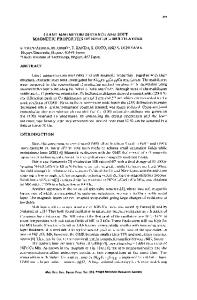Structure of Magnetic Multilayers and Magnetoresistance
- PDF / 591,317 Bytes
- 12 Pages / 414.72 x 648 pts Page_size
- 82 Downloads / 383 Views
TERUYA SHINJO Institute for Chemical Research, Kyoto University Uji, Kyoto-fu 611, Japan
ABSTRACT Magnetoresistance (MR) surveyed. As a possible current in out-of-plane layers were prepared on measure the MR in a new actually an enhanced MR
studies on non-coupled type multilayers are briefly' method to enhance MR effect, measurements with directions are described. Non-coupled type multimicrostructured substrates with V-shaped grooves to geometry, with current at-an-angle-to-the-plane, and ratio was observed.
INTRODUCTION In 1988, Baibich et al. reported that the electric resistivity of Fe/Cr multilayers changed greatly by applying magnetic fields[I]. Because of an interlayer antiferromagnetic coupling between adjacent ferromagnetic Fe layers across a non-magnetic Cr layer, which was first found by Grunberg et al.[2], Fe layer magnetizations are aligned antiparallel. If an external field is applied, magnetizations are oriented parallel. An unexpectedly large resistivity change owing to the spin-dependent scattering was observed between antiparallel and parallel configurations[3]. The antiparallelly aligned magnetic structure was confirmed by neutron diffraction experiments [4]. Many studies have been initiated for the new type magnetoresistance (MR) effect, i.e., a variation of resistivity associated with a magnetic structure change. Similar MR phenomena were found in some other multilayer systems, Co/Cu for instance[5,6]. Subsequently, granular systems also were found to exhibit large MR ratios [7,8]. If ferromagnetic clusters are dispersed in a non-magnetic matrix, Co/Cu and Co/Ag as typical examples, the 225
Mat. Res. Soc. Symp. Proc. Vol. 382 01995 Materials Research Society
magnetic structure is converted from a randomly-oriented to a parallel one by an external field. The resistivity change accompanied with the magnetic structure modification from random to parallel was found to be similar to that from antiparallel to parallel. Analogous MR properties were observed also in some compounds whose magnetic structures are able to be modified by external magnetic fields (conventionally called metanagnetism)[9,10]. All such large resistivity changes associated with magnetic structure variations are called the giant magnetoresistance(GMR). Not only from fundamental physical points of view, but also from technological points, the GMR is a very interesting subject and many investigations have been intensively carried out. In order to apply such GMR films practically for magnetic recording heads, it is required that a resistance change can be induced by a small magnetic field. A goal of GMR studies is therefore to realize large MR ratios in small fields. For this purpose, non-coupled type multilayers are advantageous, which are described in the next section.
NON-cOUPLED TYPE GMR In the case of Fe/Cr multilayers, a considerably large magnetic field, in the order of lOkOe, is necessary to induce the magnetoresistance change[1], since the antiferromagnetic interlayer coupling is fairly strong. In the other typical co
Data Loading...











